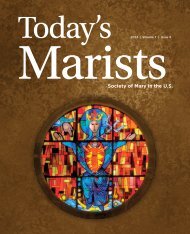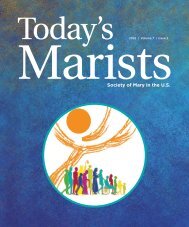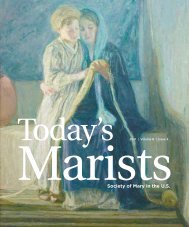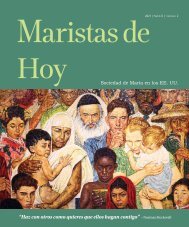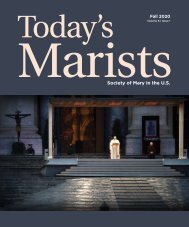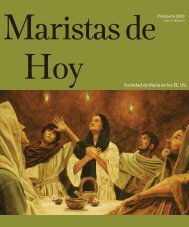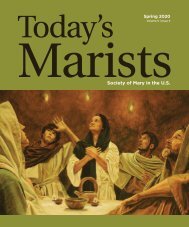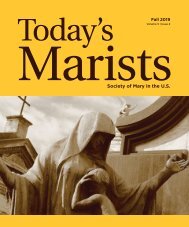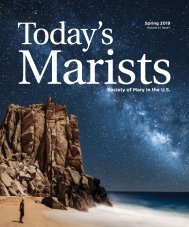Today's Marists 2024 Volume 8, Issue 2
You also want an ePaper? Increase the reach of your titles
YUMPU automatically turns print PDFs into web optimized ePapers that Google loves.
Living a Marist Life of Reconciliation<br />
in a Chaotic and Violent World<br />
by Ted Keating, SM<br />
The title for this article was the obvious<br />
theme when we gathered to prepare<br />
this issue of Today’s <strong>Marists</strong>. It was not<br />
necessary to share every concern that<br />
was on our minds and in our hearts<br />
at the meeting since so much of it was<br />
obvious: the meltdown in Israel after the<br />
horrendous slaughter of so many Jewish<br />
people in the massacre on October 7th ; the<br />
on-going stories of the thousands of deaths<br />
of the Palestinians and the destruction<br />
of their homes and hospitals with lifethreatening<br />
deficits in food, medical<br />
care and the basic necessities of life;<br />
the continuing tragedy in Ukraine; and<br />
continuing starvation in East Africa from<br />
the climate crisis. Locally in the United<br />
States, the persisting epidemic of shootings<br />
around the country only continues to build<br />
understandable fears of walking the streets<br />
and being in schools. These events and<br />
growing concerns guided us to the theme<br />
of this issue of Today’s <strong>Marists</strong> — ‘Living<br />
a Marist Life of Reconciliation in a Chaotic<br />
and Violent World.’ This theme was further<br />
confirmed through stories of young<br />
<strong>Marists</strong> around the world who are actively<br />
engaging in ministries of Reconciliation<br />
(as you will read in some of the articles in<br />
this issue).<br />
As <strong>Marists</strong>, we recognized the wisdom of<br />
our Superior General’s recent declaration<br />
that our Marist presence in these chaotic<br />
times calls forth a deeper understanding<br />
of our mission of reconciliation. It is not<br />
a change in our mission, but a deeper<br />
awareness of being “Instruments of Mercy”<br />
as a way of living our mission faithfully.<br />
In a real sense, the situation of our own<br />
chaotic times is not new. We can go back<br />
to St. Paul’s Letter to the Colossians<br />
where he says, “For in Him all the fullness<br />
was pleased to dwell, and through him<br />
to reconcile all things for Him, making<br />
peace by the blood of his cross [through<br />
him], whether those on earth or those<br />
in heaven.” (Col. 1:19-22) We find a basic<br />
insight that the whole earth is in constant<br />
need of Reconciliation, and “Christ among<br />
us” is at the center of this reconciliation by<br />
His own death and Resurrection. We are<br />
reminded of “original sin” in all this but<br />
encouraged by the grace of Christ among<br />
us, reconciling all.<br />
In the Letter to the Ephesians after decades<br />
of conflicts between Jew and Gentile in the<br />
early Church, St. Paul says of this “mystery<br />
hidden since the foundations of the world”<br />
in this late letter. He writes there:<br />
“…you can understand my insight<br />
into the mystery of Christ, which<br />
was not made known to human<br />
beings in other generations, as<br />
it has now been revealed to his<br />
holy apostles and prophets by the<br />
Spirit that the Gentiles are coheirs,<br />
members of the same body, and<br />
copartners in the promise in Christ<br />
Jesus through the gospel.” (Eph.<br />
3:3-6)<br />
Our world then and now is only made<br />
up of Jew and Gentile, so this is the<br />
reconciliation of all of humanity in this<br />
plan of God from all eternity. In Chapter<br />
4 of St. Paul’s Letter to the Ephesians, he<br />
emphasizes the critical need for unity in<br />
the Church and sets out the attitudes that<br />
encourage it and/or undermine it. So,<br />
after the reconciliation of all humanity<br />
(Jew and Gentile), and the reconciliation<br />
of all humanity with God, the Church<br />
moved into its pilgrimage through history<br />
with this ministry of reconciliation for all<br />
humanity.<br />
The Second Vatican Council (Vatican<br />
II) laid the groundwork for an agenda of<br />
reconciliation for all humanity through<br />
several topics seeking to enrich its pastoral<br />
implementation of the call from these two<br />
letters of St. Paul on the reconciliation of<br />
all humanity:<br />
• Ecumenism: This decree on Christian<br />
unity emphasized healing divisions<br />
among Christians. It encouraged<br />
dialogue and respect for the traditions<br />
of other Christian denominations. This<br />
marked a shift from previous stances<br />
that viewed other Christian faiths as<br />
unfaithful to the Christian tradition.<br />
• Interfaith Dialogue: The council also<br />
opened the door to dialogue with<br />
followers of non-Christian religions.<br />
This showed a recognition of the value of<br />
other faith traditions and a willingness<br />
to find common ground with them. St.<br />
John Paul II would say later that the Holy<br />
Spirit is alive in these religions.<br />
• Human Dignity: The beautiful and<br />
transforming document Gaudium et<br />
Spes (“Joy and Hope”), promulgated<br />
by Pope Paul VI in 1965, addressed the<br />
Church’s relationship with the whole<br />
modern world. It emphasized the<br />
inherent dignity of all human beings,<br />
regardless of religion, background,<br />
status/class or nationality. This laid<br />
the foundation for building bridges<br />
and fostering understanding across<br />
differences in the hope of building a<br />
just and respectful world. A later Synod<br />
went so far as to say that such work is<br />
“constitutive of the proclamation of the<br />
Gospel.” (Justice in the World, Synod of<br />
Bishops, 1971)<br />
• Universal Peace: The council addressed<br />
the need for continuing peace between<br />
nations and the importance of working<br />
for peace, justice and human rights.<br />
Pope Paul VI’s motto was “If you want<br />
peace, work for justice,” referencing<br />
the integration of justice and peace<br />
in avoiding war. Just after Vatican<br />
II and months after the 1962 Cuban<br />
Missile Crisis, the beloved Pope John<br />
the XXIII issued the transforming<br />
encyclical Pacem in Terris (Peace on<br />
Earth) in 1963. To the whole world, this<br />
transforming document dramatically<br />
shifted the Church’s pastoral mission<br />
in ways that lay a foundation for a focus<br />
on the reconciliation of relationships as<br />
central to these issues.<br />
This brings us finally to the role of Pope<br />
Francis who has spent much of his papacy<br />
bringing Vatican II more clearly to the<br />
center of the Church. In 2020 he issued<br />
his third encyclical Fratelli Tutti (On<br />
Fraternity and Social Friendship). Pope<br />
Francis’ second encyclical, Laudato<br />
Si’ (Praise be to you – On Care for Our<br />
Common Home), published in 2015,<br />
pleaded for a world effort to take action<br />
concerning the critical dangers to human<br />
survival from the climate crisis. Another<br />
significant writing by Pope Francis<br />
4 Today’s <strong>Marists</strong> Magazine




